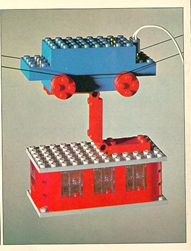I received my first Lego® box from my parents circa 1968 – a year marked by a few other events of possibly equal importance ![]() . I clearly remember my excitement at assembling all these colored bricks together, inventing small cars and buildings and other things of interest to a young boy. However, there came a time when I ran out of ideas. I didn’t notice this at first but my parents did, so they bought me the Lego Idea Book, page after page of endlessly creative possibilities within the Lego universe. It was another revelation.
. I clearly remember my excitement at assembling all these colored bricks together, inventing small cars and buildings and other things of interest to a young boy. However, there came a time when I ran out of ideas. I didn’t notice this at first but my parents did, so they bought me the Lego Idea Book, page after page of endlessly creative possibilities within the Lego universe. It was another revelation.
Look at the cable car set-up below, a page from the Logo idea Book published at that time. When you see that, you just say “Wow, this is genius!”. First, it’s made up of very simple Lego bricks, including the locomotive engine every Lego user received at that time. Second, it applied a very unusual yet efficient way to use motorized wheels. Third, the sewing thread was a great way to physically connect this Lego device to the real world (my bed and my bedroom chair). No way I could have made that up.

As I grew older, while I was acquiring more and more bricks (stored in giant laundry soap barrels), Lego itself grew by adding “stuff”: specifically, by releasing predefined models focused on predefined themes (e.g. a train station, a furnished house, a hospital, a harbor, etc.) coined with the name Legoland®. Before it became a family theme park, Legoland was the meeting place of all Lego models related to real-life economic activities.

As they went full speed in this direction, multiplying themes, Lego created very specific bricks designed for very specific models that you couldn’t reuse anywhere else. Apart from the (immediate) satisfaction of creating a model out of the box, it was very hard to start from a blank page and invent new set-ups. Fortunately, Lego has recognized this in recent years and went back to basics, creating the “Classic” theme along with idea books about the essentials, enabling all of us to be creative builders again.
Have an idea of where I’m going with all of this - beyond a trip down memory lane?
As early as 2011, Intuiface brought to the market a platform full of Lego-like building blocks. We went on to release models in the form of templates and samples in the Marketplace, always making sure these models never needed more than basic bricks. If we needed a new brick, we would build it and retrofit all existing models in need of such a brick (yeah, we can do that with software…). These models proved very helpful for those getting to know Intuiface but for the experienced, they lacked sufficient guidance for application in the real world. As a result, we felt it was time to create our own Legoland. Intuiface guidance for the real world.
We’ve built that world, and we’ve called it Intuiville.
Intuiville is a town where Intuiface is the attraction. In it we’ve highlighted 50+ scenarios across nine verticals, featuring all of the ways interactivity could be used to educate, inform, inspire, promote, and more. This is not just about touch. It’s about any type of interaction like sensors, voice recognition, and beacons. It’s also not about the top 5% of Intuiface users. The goal of Intuiville is to explain how anyone, of any skill set, can adopt any type of interactivity and use it in their place of business.
Each scenario is accompanied by a business value discussion, a list of applicable Intuiface features, sample experiences illustrating these features in action, and customer videos showing real-world results. There is no better source of inspiration because all are well explained and immediately actionable.
We are opening the town to business today: Check out https://intuiville.intuiface.com and our great Intuiville Intuiface Experience available on the Marketplace!
We hope each Intuiface user will discover her own cable car set-up in one of the many Intuiface scenarios showcased in Intuiville, triggering a definitive ah-ah moment leading to market innovation and business success!
See you there!
Vincent
